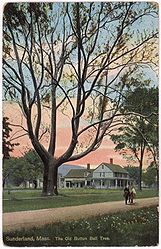
The moose or elk is the world's tallest, largest and heaviest extant species of deer and the only species in the genus Alces. It is also the tallest, and the second-largest, land animal in North America, falling short only of the American bison in body mass. Most adult male moose have broad, palmate antlers; other members of the deer family have pointed antlers with a dendritic ("twig-like") configuration. Moose inhabit the circumpolar boreal forests or temperate broadleaf and mixed forests of the Northern Hemisphere, thriving in cooler, temperate areas as well as subarctic climates.
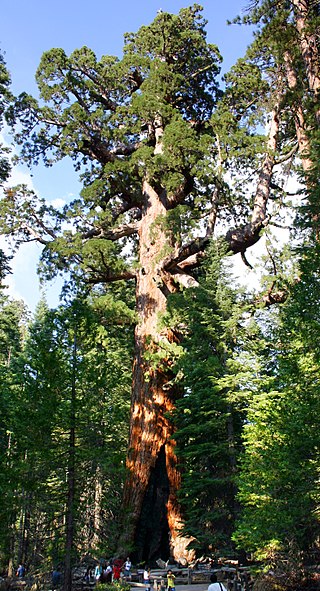
Sequoiadendron giganteum, also known as the giant sequoia, giant redwood or Sierra redwood is a coniferous tree, classified in the family Cupressaceae in the subfamily Sequoioideae. Giant sequoia specimens are the most massive trees on Earth. They are native to the groves on the western slopes of the Sierra Nevada mountain range of California but are grown around the world.

Quercus alba, the white oak, is one of the preeminent hardwoods of eastern and central North America. It is a long-lived oak, native to eastern and central North America and found from Minnesota, Ontario, Quebec, and southern Maine south as far as northern Florida and eastern Texas. Specimens have been documented to be over 450 years old.

Ulmus americana, generally known as the American elm or, less commonly, as the white elm or water elm, is a species of elm native to eastern North America. The trees can live for several hundred years. It is a very hardy species that can withstand low winter temperatures, but it is affected by Dutch elm disease.

Sycamore is a city in DeKalb County, Illinois, United States. It has a commercial district based and centered on Illinois Route 64. The population was 18,577 at the 2020 census, up from 17,419 at the 2010 census. Sycamore is the county seat of DeKalb County and was named after the sycamore tree.

Leverett is a town in Franklin County, Massachusetts, United States. The population was 1,865 as of the 2020 census. It is part of the Springfield, Massachusetts Metropolitan Statistical Area.
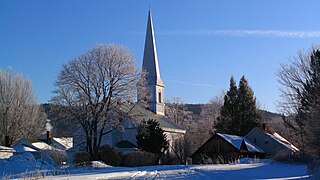
Sunderland is a town in Franklin County, Massachusetts, United States, part of the Pioneer Valley. The population was 3,663 at the 2020 census. It is part of the Springfield, Massachusetts Metropolitan Statistical Area.
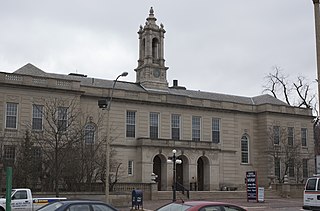
Arlington is a town in Middlesex County, Massachusetts, United States. The town is six miles (10 km) northwest of Boston, and its population was 46,308 at the 2020 census.

Quercus robur, the pedunculate oak, is a species of flowering plant in the beech and oak family, Fagaceae. It is a large tree, native to most of Europe and western Asia, and is widely cultivated in other temperate regions. It grows on soils of near neutral acidity in the lowlands and is notable for its value to natural ecosystems, supporting a very wide diversity of herbivorous insects and other pests, predators and pathogens.

General Sherman is a giant sequoia tree located at an elevation of 2,109 m (6,919 ft) above sea level in the Giant Forest of Sequoia National Park in Tulare County, in the U.S. state of California. By volume, it is the largest known living single-stem tree on Earth.
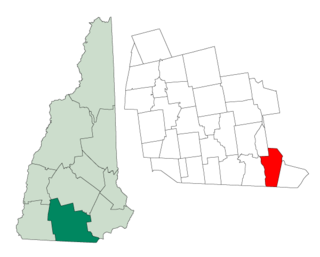
Hudson is a town in Hillsborough County, New Hampshire, United States. It is located along the Massachusetts state line. The population was 25,394 at the 2020 census. It is the tenth-largest municipality in the state, by population.

Platanus occidentalis, also known as American sycamore, American planetree, western plane, occidental plane, buttonwood, and water beech, is a species of Platanus native to the eastern and central United States, the mountains of northeastern Mexico, extreme southern Ontario, and extreme southern Quebec. It is usually called sycamore in North America, a name which can refer to other types of trees in other parts of the world. The American sycamore is a long-lived species, typically surviving at least 200 years and likely as long as 500–600 years.

Pinus strobus, commonly called the eastern white pine, northern white pine, white pine, Weymouth pine (British), and soft pine is a large pine native to eastern North America. It occurs from Newfoundland, Canada, west through the Great Lakes region to southeastern Manitoba and Minnesota, United States, and south along the Appalachian Mountains and upper Piedmont to northernmost Georgia and perhaps very rarely in some of the higher elevations in northeastern Alabama. It is considered rare in Indiana.

Tsuga canadensis, also known as eastern hemlock, eastern hemlock-spruce, or Canadian hemlock, and in the French-speaking regions of Canada as pruche du Canada, is a coniferous tree native to eastern North America. It is the state tree of Pennsylvania. Eastern hemlocks are widespread throughout much of the Great Lakes region, the Appalachian Mountains, the Northeastern United States, and Maritime Canada. They have been introduced in the United Kingdom and mainland Europe, where they are used as ornamental trees.
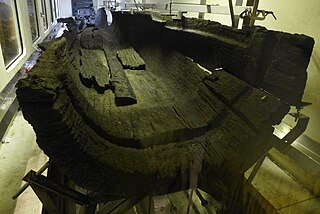
Hasholme logboat is a late Iron Age boat discovered at Hasholme, an area of civil parish of Holme-on-Spalding-Moor in the East Riding of the English county of Yorkshire. It is now on display in the Hull and East Riding Museum, in Hull.
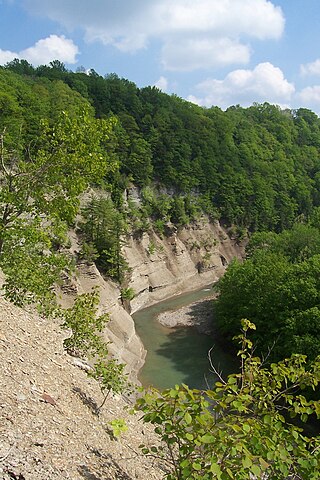
Zoar Valley is an area of deep gorges along the Main and South branches of Cattaraugus Creek in western New York, United States. The valley is located along the border of Erie County and Cattaraugus County, roughly between the villages of Gowanda to the west and Springville to the east.
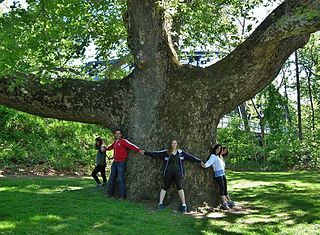
The Pinchot Sycamore is a large American sycamore in Simsbury, Connecticut. It is the largest tree in Connecticut. When measured by the Connecticut Botanical Society in 2016, the Pinchot Sycamore's trunk was over 28 feet (8.5 m) around and 100 feet (30 m) tall, with an average canopy diameter of 121 feet (37 m). The sycamore is estimated to be at least 200 years old, and possibly over 300 years old. The tree was named in honor of influential conservationist and Connecticut resident Gifford Pinchot. It was originally dedicated to Pinchot in 1965, and re-dedicated with an engraved stone marker in 1975.
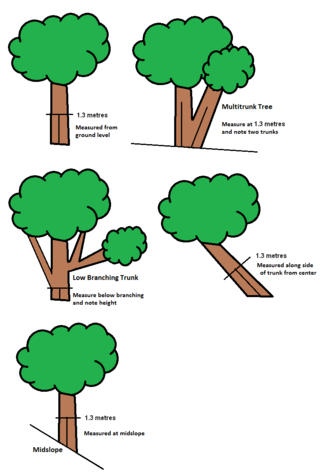
Tree girth is a measurement of the circumference of tree trunk. It is one of the most ancient, quickest, and simplest of foresters' measures of size and records of growth of living and standing trees. The methods and equipment have been standardized differently in different countries. A popular use of this measurement is to compare outstanding individual trees from different locations or of different species.

The Webster Sycamore was an American sycamore in the U.S. state of West Virginia. Long recognized for its size, the Webster Sycamore was the largest living American sycamore tree in West Virginia until its felling in 2010. The tree stood approximately 4.5 miles (7.2 km) east of Webster Springs in Webster County, in a moist flood plain along the banks of the Back Fork Elk River, a tributary stream of the Elk River.

Maraapunisaurus is a genus of sauropod dinosaur from the Late Jurassic Morrison Formation of western North America. Originally named Amphicoelias fragillimus, it has sometimes been estimated to be the largest dinosaur specimen ever discovered. Based on surviving descriptions of a single fossil bone, scientists have produced numerous size estimates over the years; the largest estimate M. fragillimus to have been the longest known animal at 58 metres (190 ft) in length with a mass of 150 tonnes. However, because the only fossil remains were lost at some point after being studied and described in the 1870s, evidence survived only in contemporary drawings and field notes.



